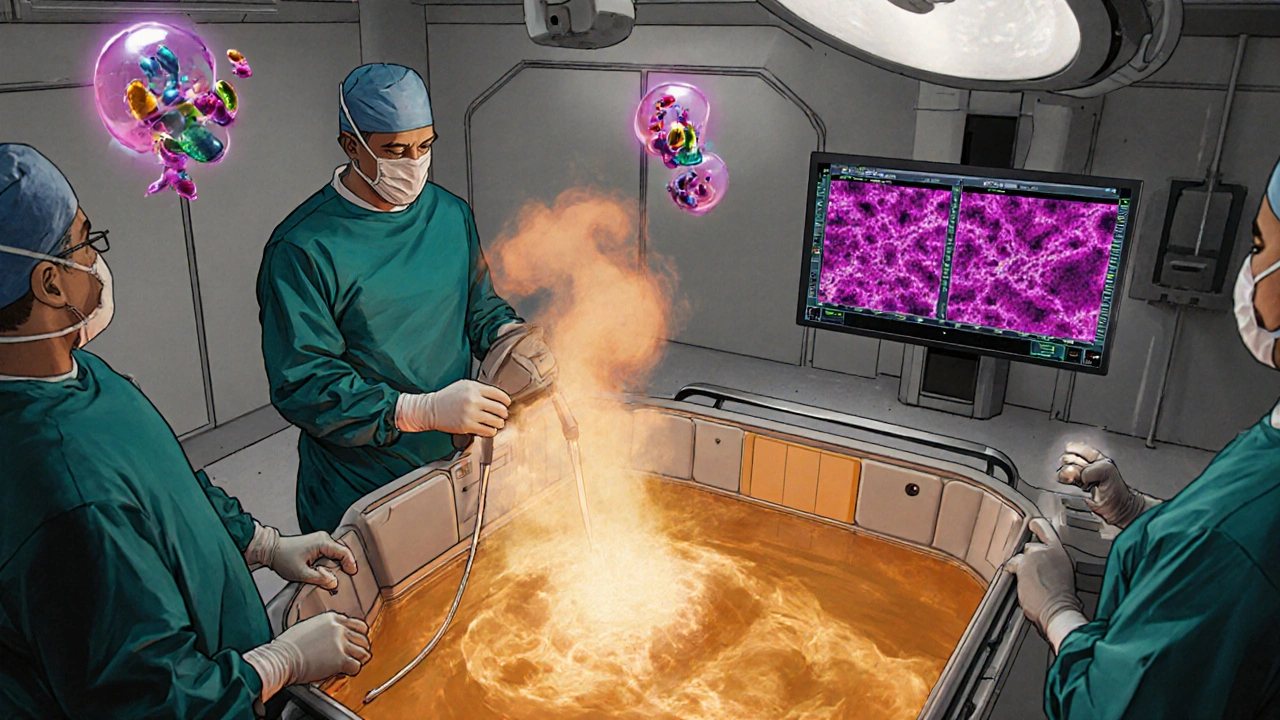PARP Inhibitor Eligibility Calculator
Based on the latest research, PARP inhibitors like olaparib and niraparib can significantly extend progression-free survival for eligible ovarian cancer patients. This calculator helps determine if you might be eligible for these treatments based on your BRCA status and HRD results.
Results will appear here after calculating...
Key Takeaways
- Early detection tools like liquid biopsy are moving from research to routine care.
- PARP inhibitors have become a front‑line option for patients with BRCA mutations.
- Immunotherapy combos are showing promise in late‑stage trials.
- Hyperthermic intraperitoneal chemotherapy (HIPEC) can extend survival after surgery.
- Personalised genomic profiling guides treatment choice and trial enrolment.
When talking about women's health, Ovarian Cancer is a malignant tumor that starts in the ovaries and is often diagnosed at an advanced stage. In the UK alone, more than 7,000 new cases are recorded each year, and the five‑year survival rate hovers around 45%. The disease’s stealthy onset makes research breakthroughs especially valuable, and the last decade has delivered several game‑changing options. This guide walks you through the most important recent advances and what they mean for patients looking toward the future.
What is Ovarian Cancer and Why Is It So Hard to Spot?
The ovaries are tiny, hormone‑producing glands tucked deep in the pelvis. Cancer can arise from the surface epithelium (the most common type), from germ cells, or from stromal tissue. Because early tumours are small and cause vague symptoms-bloating, pelvic pressure, or changes in bowel habits-many women don’t seek help until the cancer has spread beyond the ovary.
Key statistics (2024 data from Cancer Research UK):
- Incidence: ~7,500 new diagnoses per year in the UK.
- Mortality: ~4,500 deaths annually.
- Late‑stage (stage III/IV) presentation: ~70% of cases.
These numbers highlight why early‑detection research is a top priority.
Standard Treatment Landscape Today
Historically, the backbone of therapy has been cytoreductive surgery followed by platinum‑based chemotherapy (carboplatin and paclitaxel). While this combo can shrink tumours, recurrence rates are high, especially in patients without a BRCA mutation. The median progression‑free survival (PFS) after first‑line therapy sits at roughly 12-14 months.
Because the disease is often widespread at diagnosis, the surgical goal is maximising tumour removal-often called "optimal debulking"-which improves overall survival. Yet the surgery alone isn’t enough; researchers have been layering new systemic agents on top of this foundation.
Targeted Therapy Breakthrough: PARP Inhibitors
Poly (ADP‑ribose) polymerase (PARP) inhibitors exploit a weakness in tumour cells that can’t repair DNA damage efficiently. Women with germline or somatic BRCA1/2 mutations, or broader homologous recombination deficiency (HRD), benefit most.
PARP inhibitors are a class of drugs that block an enzyme crucial for DNA repair, causing cancer cells to die. The first to gain approval was olaparib in 2018, followed by rucaparib and niraparib. Recent PhaseIII trials (SOLO‑1, PAOLA‑1, PRIMA) show that using PARP inhibitors as maintenance therapy after first‑line chemotherapy can extend PFS to 36-44 months for eligible patients, a dramatic jump from the historical 12-14 months.
Key advantages:
- Oral administration-no infusion needed.
- Manageable side‑effects (nausea, fatigue, mild anemia).
- Benefit even in some non‑BRCA HRD cases, as shown by the HRD score‑guided sub‑analyses.
Doctors now routinely order germline and somatic BRCA testing at diagnosis to determine eligibility.

Immunotherapy: Turning the Immune System Against Cancer
Checkpoint inhibitors such as pembrolizumab (anti‑PD‑1) and nivolumab have transformed treatment of melanoma and lung cancer, but ovarian tumours have been less responsive due to a relatively “cold” tumour micro‑environment. Recent strategies aim to warm up that environment.
Immunotherapy uses drugs that release the brakes on the immune system, allowing it to recognise and attack cancer cells is now being tested in combination with anti‑angiogenic agents (like bevacizumab) and PARP inhibitors. The KEYNOTE‑100 and NRG‑GY001 trials reported overall response rates of 15-20% in heavily pre‑treated patients-a modest gain, but the durability of response (some lasting >12 months) sparked optimism.
Emerging approaches include tumor‑infiltrating lymphocyte (TIL) therapy and personalized neoantigen vaccines, both in early‑phase studies with encouraging safety signals.
Early Detection Tools: From CA‑125 to Liquid Biopsy
CA‑125, a protein released by many ovarian tumours, has been the cornerstone biomarker for decades. However, its specificity is low-elevated levels occur in endometriosis, fibroids, and even menstruation.
Enter Liquid biopsy a blood test that detects circulating tumour DNA (ctDNA) or tumour‑derived exosomes. A 2024 NEJM study showed that a panel combining ctDNA mutation detection, methylation patterns, and CA‑125 achieved 92% sensitivity for stageI disease, compared with 58% for CA‑125 alone.
Other promising markers include HE4, the ROMA algorithm (combining CA‑125 and HE4), and the Risk of Ovarian Malignancy Algorithm (ROMA). While none are yet approved for population screening, they’re gradually entering high‑risk surveillance protocols.
Innovative Surgical Options: HIPEC and Risk‑Reducing Surgery
Hyperthermic intraperitoneal chemotherapy (HIPEC) delivers heated chemo directly into the abdomen during surgery, aiming to eradicate microscopic disease left behind after tumour removal.
HIPEC involves circulating heated chemotherapy agents within the peritoneal cavity for 60-90 minutes after cytoreductive surgery. The 2023 OVHIPEC trial demonstrated a median overall survival gain of 11 months for stageIII patients receiving HIPEC versus surgery alone.
For women with a strong family history or confirmed BRCA mutation, risk‑reducing salpingo‑oophorectomy (RRSO) is recommended between ages 35‑40 (or 5-10 years before the earliest family case). Laparoscopic RRSO cuts the lifetime ovarian cancer risk by over 80% and also lowers breast cancer risk when performed before menopause.
Personalised Medicine: Genomic Profiling and Clinical Trials
Comprehensive genomic profiling (CGP) now costs less than £500 and can be performed on tumour tissue or ctDNA. CGP reports reveal actionable alterations such as:
- BRCA1/2 mutations - guide PARP inhibitor use.
- PIK3CA, AKT, PTEN changes - candidates for PI3K/AKT pathway inhibitors.
- FGFR alterations - potential eligibility for FGFR inhibitors (in trials).
Patients are encouraged to discuss trial enrolment early, as many studies require pre‑treatment biopsies. The UK’s National Cancer Research Institute (NCRI) runs the OVCARE network, matching patients to over 200 open studies.

Future Directions: What to Expect in the Next Five Years
Several trends are converging:
- Combination regimens that pair PARP inhibitors with anti‑angiogenics, checkpoint inhibitors, or novel DNA‑damage response agents.
- Use of Clinical trials structured research studies that test new treatments or combinations in patients as a standard part of care, similar to breast cancer pathways.
- Integration of AI‑driven imaging analysis to predict tumour spread and guide surgical planning.
- Wider deployment of liquid‑biopsy screening for high‑risk groups, potentially catching disease at stageI.
- Development of vaccine‑based therapies that target tumour‑specific neoantigens.
For patients, the takeaway is hope: each new tool adds a piece to the puzzle, turning ovarian cancer from a terminal diagnosis into a chronic, manageable condition for many.
Practical Checklist for Patients and Caregivers
- Ask for germline and somatic BRCA testing at diagnosis.
- Discuss eligibility for PARP‑inhibitor maintenance after first‑line chemo.
- Inquire about clinical trials, especially those combining PARP inhibitors with immunotherapy.
- If you carry a BRCA mutation, consider risk‑reducing surgery before age 40.
- Stay informed about liquid‑biopsy surveillance programs if you’re high‑risk.
Comparative Overview of Current and Emerging Treatments
| Modality | Typical Indication | Median PFS (months) | Key Side‑effects |
|---|---|---|---|
| Platinum‑taxane chemotherapy | All patients, stage III/IV | 12-14 | Nausea, neuropathy, myelosuppression |
| PARP inhibitor maintenance | BRCA‑mutated or HRD‑positive | 36-44 | Anemia, fatigue, nausea |
| Bevacizumab (anti‑angiogenic) + chemo | High‑risk stage III | 16-18 | Hypertension, proteinuria |
| Immunotherapy (PD‑1/PD‑L1) ± PARP | Recurrent, PD‑L1‑positive (clinical trials) | ~20 (in combo studies) | Immune‑related colitis, rash |
| HIPEC (post‑surgery) | Stage III cytoreduction | +11 months OS (vs surgery alone) | Renal toxicity, abdominal pain |
Frequently Asked Questions
What is the role of BRCA testing in ovarian cancer?
BRCA testing identifies mutations that make tumours vulnerable to PARP inhibitors. Both germline (inherited) and somatic (tumour‑acquired) tests are recommended at diagnosis because they guide maintenance therapy and inform family‑risk counseling.
Can liquid biopsy replace tissue biopsy?
Not yet. Liquid biopsy excels at detecting circulating DNA and monitoring treatment response, but a tissue sample remains the gold standard for definitive histology and full genomic profiling.
Is HIPEC suitable for all ovarian cancer patients?
HIPEC is currently offered mainly to patients with stageIII disease who undergo optimal cytoreduction. Ongoing trials are testing its benefit in earlier stages, but it’s not standard for every case.
How do I find a clinical trial?
Talk to your oncologist about the UK’s OVCARE network or use the NHS clinical trials portal. Provide your genomic report; many trials screen for specific mutations like BRCA or HRD.
What lifestyle changes can support treatment?
Maintain a balanced diet rich in antioxidants, stay physically active, and avoid smoking. While lifestyle alone won’t cure the disease, it can improve tolerance to chemotherapy and overall well‑being.

Shivam yadav
September 24, 2025
Genetic testing at diagnosis is becoming the new standard, and it really helps us match patients with the right maintenance therapy. In many Indian families, discussing hereditary risk can be sensitive, but the data shows a clear survival benefit for BRCA‑positive cases. PARP inhibitors such as olaparib have pushed progression‑free survival well beyond the old 12‑month mark. When clinicians order both germline and somatic panels early, treatment decisions can be made without delay. It also gives relatives a chance to get tested and consider risk‑reducing options.
pallabi banerjee
October 8, 2025
The liquid‑biopsy panel is a game changer for early detection.
Alex EL Shaar
October 22, 2025
Yo, the newest ctDNA assays are blowing up the scene – they scoop up tumour fragments from a simple blood draw and spit out mutation maps faster than you can say “chemo”. Most labs still cling to CA‑125, which is basically a noisy alarm that goes off for fibroids or even a bad period, so the combo test is a massive upgrade. Trials in 2024 showed 92% sensitivity for stage‑I disease, which is insane compared to the old 58% figure. That means we can actually catch ovarian cancer before it does the whole “hide in the pelvis” trick. The tech is still pricey, but prices are dropping like a hot potato. I’d say we’re on the brink of turning a fatal diagnosis into a chronic, manageable condition. Bottom line: keep an eye on those liquid‑biopsy panels, they’re the future.